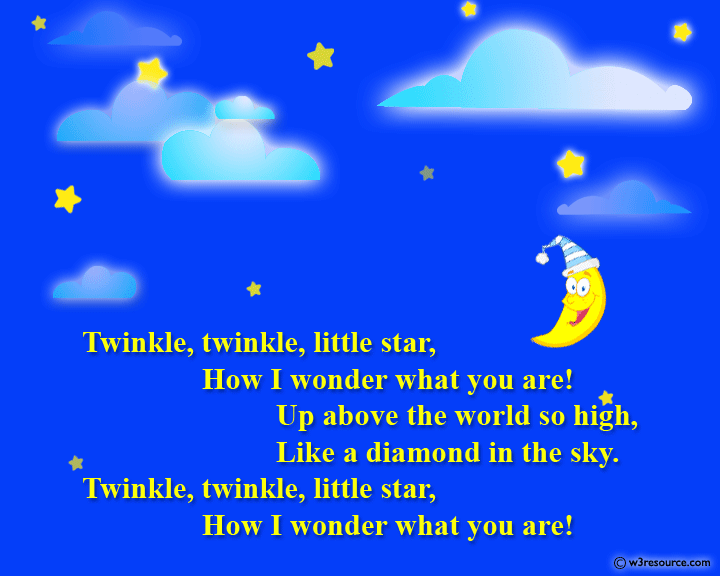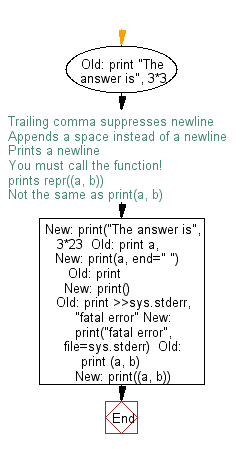Python: Print a string in a specified format
Python Basic: Exercise-1 with Solution
Write a Python program to print the following string in a specific format (see the output).
Sample String: "Twinkle, twinkle, little star, How I wonder what you are! Up above the world so high, Like a diamond in the sky. Twinkle, twinkle, little star, How I wonder what you are!"
The print statement (Python 2.6) has been replaced with a print() function (Python 2.6), with keyword arguments to replace most of the special syntax of the old print statement .
- The print() function doesn’t support the “softspace” feature of the old print statement. For example, in Python 2.x, print "A\n", "B" would write "A\nB\n"; but in Python 3.0, print("A\n", "B") writes "A\n B\n".
- Initially, you’ll be finding yourself typing the old print x a lot in interactive mode. Time to retrain your fingers to type print(x) instead!
- When using the 2to3 source-to-source conversion tool, all print statements are automatically converted to print() function calls, so this is mostly a non-issue for larger projects.
Pictorial Presentation:

Examples:
Old: print "The answer is", 3*3
New: print("The answer is", 3*23
Old: print a, # Trailing comma suppresses newline
New: print(a, end=" ") # Appends a space instead of a newline
Old: print # Prints a newline
New: print() # You must call the function!
Old: print >>sys.stderr, "fatal error"
New: print("fatal error", file=sys.stderr)
Old: print (a, b) # prints repr((a, b))
New: print((a, b)) # Not the same as print(a, b)Sample Solution:-
Python Code:
print("Twinkle, twinkle, little star, \n\tHow I wonder what you are! \n\t\tUp above the world so high, \n\t\tLike a diamond in the sky. \nTwinkle, twinkle, little star, \n\tHow I wonder what you are!")
Output:
Twinkle, twinkle, little star, How I wonder what you are! Up above the world so high, Like a diamond in the sky. Twinkle, twinkle, little star, How I wonder what you are!
Flowchart:

Visualize Python code execution:
The following tool visualize what the computer is doing step-by-step as it executes the said program:
Python Code Editor:
Have another way to solve this solution? Contribute your code (and comments) through Disqus.
Previous: Python Basic Exercises Home.
Next: Write a Python program to get the Python version you are using.
What is the difficulty level of this exercise?
Test your Programming skills with w3resource's quiz.
Python: Tips of the Day
Find current directory and file's directory:
To get the full path to the directory a Python file is contained in, write this in that file:
import os dir_path = os.path.dirname(os.path.realpath(__file__))
(Note that the incantation above won't work if you've already used os.chdir() to change your current working directory, since the value of the __file__ constant is relative to the current working directory and is not changed by an os.chdir() call.)
To get the current working directory use
import os cwd = os.getcwd()
Documentation references for the modules, constants and functions used above:
- The os and os.path modules.
- The __file__ constant
- os.path.realpath(path) (returns "the canonical path of the specified filename, eliminating any symbolic links encountered in the path")
- os.path.dirname(path) (returns "the directory name of pathname path")
- os.getcwd() (returns "a string representing the current working directory")
- os.chdir(path) ("change the current working directory to path")
Ref: https://bit.ly/3fy0R6m
- New Content published on w3resource:
- HTML-CSS Practical: Exercises, Practice, Solution
- Java Regular Expression: Exercises, Practice, Solution
- Scala Programming Exercises, Practice, Solution
- Python Itertools exercises
- Python Numpy exercises
- Python GeoPy Package exercises
- Python Pandas exercises
- Python nltk exercises
- Python BeautifulSoup exercises
- Form Template
- Composer - PHP Package Manager
- PHPUnit - PHP Testing
- Laravel - PHP Framework
- Angular - JavaScript Framework
- Vue - JavaScript Framework
- Jest - JavaScript Testing Framework
